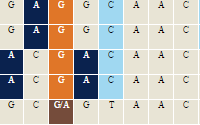Crb2
(Rattus norvegicus - Norway rat) |
| Rat Assembly | Chr | Position (strand) | Source | Genome Browsers |
|---|
| JBrowse | NCBI | UCSC | Ensembl |
|---|
GRCr8 | 3 | 41,946,694 - 41,974,629 (+) | NCBI | | GRCr8 | | | mRatBN7.2 | 3 | 21,542,138 - 21,564,876 (+) | NCBI | mRatBN7.2 | mRatBN7.2 | | | mRatBN7.2 Ensembl | 3 | 21,542,221 - 21,563,294 (+) | Ensembl | | mRatBN7.2 Ensembl | | | UTH_Rnor_SHR_Utx | 3 | 25,010,380 - 25,030,705 (+) | NCBI | Rnor_SHR | UTH_Rnor_SHR_Utx | | | UTH_Rnor_SHRSP_BbbUtx_1.0 | 3 | 33,595,339 - 33,615,663 (+) | NCBI | Rnor_SHRSP | UTH_Rnor_SHRSP_BbbUtx_1.0 | | | UTH_Rnor_WKY_Bbb_1.0 | 3 | 31,407,370 - 31,427,643 (+) | NCBI | Rnor_WKY | UTH_Rnor_WKY_Bbb_1.0 | | | Rnor_6.0 | 3 | 22,037,812 - 22,061,247 (+) | NCBI | Rnor6.0 | Rnor_6.0 | rn6 | Rnor6.0 | Rnor_6.0 Ensembl | 3 | 22,038,357 - 22,058,871 (+) | Ensembl | Rnor6.0 | | rn6 | Rnor6.0 | Rnor_5.0 | 3 | 27,273,846 - 27,296,956 (+) | NCBI | Rnor5.0 | Rnor_5.0 | rn5 | Rnor5.0 | RGSC_v3.4 | 3 | 17,539,288 - 17,559,629 (+) | NCBI | RGSC3.4 | RGSC_v3.4 | rn4 | RGSC3.4 | RGSC_v3.1 | 3 | 17,436,230 - 17,456,001 (+) | NCBI | | | | | Celera | 3 | 19,976,389 - 19,996,310 (+) | NCBI | | Celera | | | Cytogenetic Map | 3 | q11 | NCBI | | | | |
|
CRB2
(Homo sapiens - human) |
| Human Assembly | Chr | Position (strand) | Source | Genome Browsers |
|---|
| JBrowse | NCBI | UCSC | Ensembl |
|---|
GRCh38 | 9 | 123,354,065 - 123,380,326 (+) | NCBI | GRCh38 | GRCh38 | hg38 | GRCh38 | GRCh38.p14 Ensembl | 9 | 123,356,170 - 123,380,324 (+) | Ensembl | GRCh38 | | hg38 | GRCh38 | GRCh37 | 9 | 126,118,476 - 126,142,605 (+) | NCBI | GRCh37 | GRCh37 | hg19 | GRCh37 | Build 36 | 9 | 125,158,269 - 125,180,853 (+) | NCBI | NCBI36 | Build 36 | hg18 | NCBI36 | Build 34 | 9 | 123,198,002 - 123,215,932 | NCBI | | | | | Celera | 9 | 96,766,676 - 96,789,262 (+) | NCBI | | Celera | | | Cytogenetic Map | 9 | q33.3 | NCBI | | | | | HuRef | 9 | 95,733,274 - 95,755,982 (+) | NCBI | | HuRef | | | CHM1_1 | 9 | 126,267,137 - 126,289,699 (+) | NCBI | | CHM1_1 | | | T2T-CHM13v2.0 | 9 | 135,551,766 - 135,578,059 (+) | NCBI | | T2T-CHM13v2.0 | | |
|
Crb2
(Mus musculus - house mouse) |
| Mouse Assembly | Chr | Position (strand) | Source | Genome Browsers |
|---|
| JBrowse | NCBI | UCSC | Ensembl |
|---|
GRCm39 | 2 | 37,666,238 - 37,689,115 (+) | NCBI | GRCm39 | GRCm39 | mm39 | | GRCm39 Ensembl | 2 | 37,666,261 - 37,689,115 (+) | Ensembl | | GRCm39 Ensembl | | | GRCm38 | 2 | 37,776,225 - 37,799,103 (+) | NCBI | GRCm38 | GRCm38 | mm10 | GRCm38 | GRCm38.p6 Ensembl | 2 | 37,776,249 - 37,799,103 (+) | Ensembl | GRCm38 | | mm10 | GRCm38 | MGSCv37 | 2 | 37,631,769 - 37,654,623 (+) | NCBI | GRCm37 | MGSCv37 | mm9 | NCBIm37 | Celera | 2 | 37,461,524 - 37,484,418 (+) | NCBI | | Celera | | | Cytogenetic Map | 2 | B | NCBI | | | | | cM Map | 2 | 24.19 | NCBI | | | | |
|
Crb2
(Chinchilla lanigera - long-tailed chinchilla) |
| Chinchilla Assembly | Chr | Position (strand) | Source | Genome Browsers |
|---|
| JBrowse | NCBI | UCSC | Ensembl |
|---|
ChiLan1.0 Ensembl | NW_004955419 | 4,607,507 - 4,626,608 (-) | Ensembl | ChiLan1.0 | | | | ChiLan1.0 | NW_004955419 | 4,604,883 - 4,626,675 (-) | NCBI | ChiLan1.0 | ChiLan1.0 | | |
|
CRB2
(Pan paniscus - bonobo/pygmy chimpanzee) |
| Bonobo Assembly | Chr | Position (strand) | Source | Genome Browsers |
|---|
| JBrowse | NCBI | UCSC | Ensembl |
|---|
NHGRI_mPanPan1-v2 | 11 | 15,966,284 - 16,003,414 (-) | NCBI | | NHGRI_mPanPan1-v2 | | | NHGRI_mPanPan1 | 9 | 15,968,928 - 16,005,767 (-) | NCBI | | NHGRI_mPanPan1 | | | Mhudiblu_PPA_v0 | 9 | 94,473,423 - 94,511,285 (+) | NCBI | Mhudiblu_PPA_v0 | Mhudiblu_PPA_v0 | panPan3 | | PanPan1.1 | 9 | 123,011,887 - 123,034,544 (+) | NCBI | panpan1.1 | PanPan1.1 | panPan2 | | PanPan1.1 Ensembl | 9 | 123,011,968 - 123,032,855 (+) | Ensembl | panpan1.1 | | panPan2 | |
|
CRB2
(Canis lupus familiaris - dog) |
| Dog Assembly | Chr | Position (strand) | Source | Genome Browsers |
|---|
| JBrowse | NCBI | UCSC | Ensembl |
|---|
CanFam3.1 | 9 | 59,427,661 - 59,450,436 (-) | NCBI | CanFam3.1 | CanFam3.1 | canFam3 | CanFam3.1 | CanFam3.1 Ensembl | 9 | 59,427,569 - 59,450,434 (-) | Ensembl | CanFam3.1 | | canFam3 | CanFam3.1 | Dog10K_Boxer_Tasha | 9 | 58,621,652 - 58,645,938 (-) | NCBI | | Dog10K_Boxer_Tasha | | | ROS_Cfam_1.0 | 9 | 60,346,151 - 60,370,373 (-) | NCBI | | ROS_Cfam_1.0 | | | ROS_Cfam_1.0 Ensembl | 9 | 60,346,149 - 60,370,391 (-) | Ensembl | | ROS_Cfam_1.0 Ensembl | | | UMICH_Zoey_3.1 | 9 | 59,104,766 - 59,129,041 (-) | NCBI | | UMICH_Zoey_3.1 | | | UNSW_CanFamBas_1.0 | 9 | 59,420,335 - 59,444,621 (-) | NCBI | | UNSW_CanFamBas_1.0 | | | UU_Cfam_GSD_1.0 | 9 | 59,512,745 - 59,536,914 (-) | NCBI | | UU_Cfam_GSD_1.0 | | |
|
Crb2
(Ictidomys tridecemlineatus - thirteen-lined ground squirrel) |
| Squirrel Assembly | Chr | Position (strand) | Source | Genome Browsers |
|---|
| JBrowse | NCBI | UCSC | Ensembl |
|---|
HiC_Itri_2 | NW_024404947 | 192,024,531 - 192,047,256 (+) | NCBI | | HiC_Itri_2 | | | SpeTri2.0 Ensembl | NW_004936487 | 11,793,005 - 11,812,934 (+) | Ensembl | SpeTri2.0 | SpeTri2.0 Ensembl | | | SpeTri2.0 | NW_004936487 | 11,793,078 - 11,813,803 (+) | NCBI | SpeTri2.0 | SpeTri2.0 | | SpeTri2.0 |
|
CRB2
(Sus scrofa - pig) |
| Pig Assembly | Chr | Position (strand) | Source | Genome Browsers |
|---|
| JBrowse | NCBI | UCSC | Ensembl |
|---|
Sscrofa11.1 Ensembl | 1 | 264,276,987 - 264,301,713 (+) | Ensembl | Sscrofa11.1 | | susScr11 | Sscrofa11.1 | Sscrofa11.1 | 1 | 264,277,549 - 264,301,731 (+) | NCBI | Sscrofa11.1 | Sscrofa11.1 | susScr11 | Sscrofa11.1 | Sscrofa10.2 | 1 | 297,886,591 - 297,910,766 (-) | NCBI | Sscrofa10.2 | Sscrofa10.2 | susScr3 | |
|
CRB2
(Chlorocebus sabaeus - green monkey) |
| Green Monkey Assembly | Chr | Position (strand) | Source | Genome Browsers |
|---|
| JBrowse | NCBI | UCSC | Ensembl |
|---|
ChlSab1.1 | 12 | 14,756,897 - 14,782,131 (-) | NCBI | ChlSab1.1 | ChlSab1.1 | chlSab2 | | ChlSab1.1 Ensembl | 12 | 14,758,618 - 14,779,514 (-) | Ensembl | ChlSab1.1 | ChlSab1.1 Ensembl | chlSab2 | | Vero_WHO_p1.0 | NW_023666079 | 1,290,401 - 1,312,970 (+) | NCBI | Vero_WHO_p1.0 | Vero_WHO_p1.0 | | |
|
Crb2
(Heterocephalus glaber - naked mole-rat) |
|








































